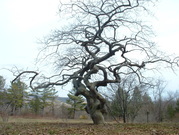Trees are often regarded as strong plants that will survive almost anywhere, but this success actually depends on choosing the right tree for the intended site.
Because every species has specific requirements, selecting the right tree for the location and climate zone is critical to its long-term survival. The basic growing requirements include the proper light, water, soil, and space. Drainage, soil texture (sand or clay), and soil pH are also factors to determine prior to planting. Other considerations are wind, reflected heat, road salt, and area wildlife. Although it is possible for some trees to acclimate to a variety of conditions, they will always be happiest when planted where the environment closely matches where they grow in the wild.

It is also important to think about the role your tree is expected to play. For example, are you planting the tree to create a hedge for wind or privacy, or is it going to create shade for your yard?
Think about what the tree will look like in 20 years. Many times people plant too close to their home, under overhead wires, or over septic systems. Then in a handful of years the tree that they have spent time nurturing has to be removed.
A simple site assessment can be done prior to planting, beginning with a complete soil fertility test that includes pH. You can find instructions for such a test at a Cornell Cooperative Extension office. (Go to their website cce.cornell.edu to find your local extension.) This test will indicate what nutrients are available and/or missing in your soil, ensuring a greater success for your investment.
After you have determined the right tree, it is important to choose a healthy specimen from the nursery. Look for a good root flair (where the trunk meets the soil) and good branch structure. Foliage will tell you a lot about the health of the tree; it should be evenly spaced rather than centered at the canopy. Avoid a tree that looks stressed from lack of water or has damage along the trunk from poor handling.
For more specifics about tree planting, mulching, and pruning, visit treesaregood.com.
